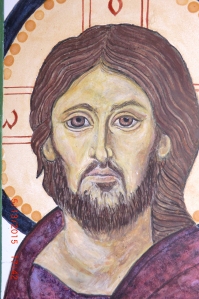The world was created by an artist. Hand-made and full of color and irregularity. The artist had a wabi-sabi sense of beauty…a Japanese aesthetic. Nothing too perfect, nothing superfluous. Take man, for example. Or even woman, 2 point O. Do we not match the definition of wabi-sabi?;
“centered on the acceptance of transience and imperfection. The aesthetic is sometimes described as one of beauty that is “imperfect, impermanent, and incomplete”.
Each of us perfect in our own imperfect way. All we have to do is look in the mirror and we are bound to notice our asymmetry–how the left side of our face does not match the left, how one foot is shorter or wider than the other.


We can spend our whole lives meditating on the nature of our existence, when wabi-sabi described it all so beautifully for us, that there are…
three marks of existence (三法印 sanbōin?), specifically impermanence (無常 mujō?), suffering (苦 ku?) and emptiness or absence of self-nature (空 kū?).
Is this not what iconography and monasticism teach us?
God has structured us in such a way that our experiences of suffering are inevitable, and that handled with grace they add to our beauty, our luminosity at the end of a life well lived. Suffering and the gradual self emptying of pride in all its many aspects. Just as iconography teaches that it is not by our own hand that the icon is created, but by the Holy Spirit working through us.
Suffering has many opportunities to make us bitter and angry, and we may retain the sharp edges that can cut and bleed others who touch us. Or, we may soften in time, our suffering having worn away those parts of ourselves we once held so true. There is a quality of suffering and meekness in the visages of icons, but only if the iconographer herself has experienced deep pain and suffering can her hand know how to transmit these qualities into the icon itself. In a sense one is able to tap into the cosmic heart which feels and bleeds with suffering of others throughout all of time. The bitter and angry isolate themselves against the world, the meek enter a communion with it.

Praise God, that at end of my life I may be as this beautiful little cup, simple, empty and having suffered many repairs, still a cup open to holding the Holy Spirit. Amen.

You must be logged in to post a comment.